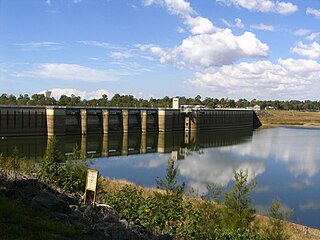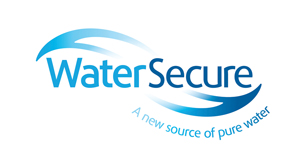
The Hinze Dam is a rock and earth-fill embankment dam with an un-gated spillway across the Nerang River in the Gold Coast hinterland of South East, Queensland, Australia. The main purpose of the dam is for potable water supply of the Gold Coast region. The impounded reservoir is called Advancetown Lake.

The Wivenhoe Dam is a rock and earth-fill embankment dam with a concrete spillway across the Brisbane River in South East Queensland, Australia. The dam takes it names from the local Wivenhoe Pocket rural community. The dam wall is located about 80 kilometres (50 mi) by road from the centre of Brisbane. The primary purpose of the dam is the supply of potable water for the Brisbane and Ipswich regions. The dam also provides for flood mitigation control, hydroelectricity, and recreation. The impounded reservoir is called Lake Wivenhoe and the dam, the lake and a narrow strip of surrounding land forms a locality also called Lake Wivenhoe.

The Leslie Harrison Dam is an earth-fill embankment dam across the Tingalpa Creek that is located in the South East region of Queensland, Australia. The main purpose of the dam is for potable water supply of the Redland City in Brisbane. The impounded reservoir is called Tingalpa Reservoir. The dam was named after Robert Leslie Harrison, a Queensland parliamentarian who died in April 1966.

The North Pine Dam is a mass concrete gravity dam with earth-fill embankments on abutments with a gated spillway across the North Pine River that is located in the South East region of Queensland, Australia. The main purpose of the dam is for supply of potable water for the Moreton Bay region and Brisbane's northern suburbs. The impounded reservoir is called Lake Samsonvale.
Brisbane Water was a former government business enterprise of the Brisbane City Council, a local government authority with administrative responsibility for the City of Brisbane, Queensland, in Australia. Brisbane Water was responsible for the distribution of reticulated potable water throughout Brisbane, as well as the treatment and transport of bulk water to the local government areas of Brisbane City, Ipswich City, Logan City, Redcliffe City, Pine Rivers Shire and Caboolture Shire. Brisbane Water operated the city's reticulated sewerage network and associated treatment plants.

The Little Nerang Dam is a concrete gravity dam with an un-gated spillway across the Little Nerang Creek that is located in the South East region of Queensland, Australia. The main purpose of the dam is for potable water supply of the Gold Coast region. The impounded reservoir is also called Little Nerang Dam. The dam was closed to the public in 2013 due to safety concerns.
The Gold Coast Desalination Plant is a 125 ML/d reverse osmosis, water desalination plant located in Bilinga, a seaside suburb of the Gold Coast, in Queensland, Australia. It supplies water to the South East Queensland region via the South East Queensland Water Grid.

The Wappa Dam is a mass concrete gravity arch dam with earth-fill abutments and an un-gated spillway across the South Maroochy River that is located in the South East region of Queensland, Australia. The main purpose of the dam is for supply of potable water for the Sunshine Coast region. The impounded reservoir is also called Wappa Dam. The dam and most of the reservoir are within Kiamba with the most northerly part of the reservoir in Cooloolabin, both in the Sunshine Coast Region.
The Poona Dam is an earth-fill embankment dam with a toe drain with an un-gated spillway across a tributary of the South Maroochy River in Kureelpa, Sunshine Coast Region, Queensland, Australia. The main purpose of the dam is for storage of potable water for the Sunshine Coast region. The impounded reservoir is also called Poona Dam.
The Ewen Maddock Dam is an earth-fill embankment dam with an un-gated spillway across the Addlington Creek that is located in Landsborough in the South East region of Queensland, Australia. The main purpose of the dam is for potable water supply of the Sunshine Coast region.
The Cedar Grove Weir is a weir located across the Logan River in the South East region of Queensland, Australia. The main purpose of the weir is for potable water storage.

The Wyaralong Dam is a mass concrete gravity dam with an un-gated spillway across the Teviot Brook that is located in the South East region of Queensland, Australia. The main purpose of the dam is for supply of potable water for the Scenic Rim region. The dam was initiated by the Queensland Government in 2006 as a result of the prolonged Millennium drought which saw the catchment areas of South East Queensland's dams receive record low rain. It was completed in 2011.

The Western Corridor Recycled Water Scheme, a recycled water project, is located in the South East region of Queensland in Australia. The scheme is managed by Seqwater and forms a key part of the SEQ Water Grid constructed by the Queensland Government in response to population growth, climate change and severe drought. The A$2.5 billion project is reported as the largest recycled water project in Australia. As of 2019, the scheme has been constructed and its performance has been validated. It remains in care and maintenance mode, and will commence operation after SEQ Water Grid dam levels reach 60%.
The Queensland Water Commission (QWC) is a defunct Queensland Government agency established to develop long term water supply strategies. The Commission was chaired by Mary Boydell and the chief executive officer was John Bradley.
As Australia's supply of freshwater is increasingly vulnerable to droughts, possibly as a result of climate change, there is an emphasis on water conservation and various regions have imposed restrictions on the use of water.

The SEQ Water Grid is a region-wide, long term, water supply scheme that provides a sustainable water infrastructure network for the South East region of Queensland, Australia. The project was the largest urban response to the drought in Australia, which severely affected water supplies in Brisbane and surrounds, particularly between 2004 and 2007. The basic component of the project was a 535-kilometre (332 mi) network of potable bulk water pipelines that connect areas that have an oversupply of water to those areas lacking water. The project went online in October 2008 and by November 2008 parts of the region were receiving a diversified supply of water for the first time.
Urban Utilities (UU) is the trading name of the Central SEQ Distributor-Retailer Authority, a statutory authority of the Government of Queensland that is responsible for the delivery of retail water supply and wastewater services across five local government areas in South East Queensland, in Australia. The shareholders of the statutory authority are the councils of Brisbane, Ipswich, Lockyer Valley, Scenic Rim, and Somerset.

LinkWater, the trading name of the Queensland Bulk Water Transport Authority, a former statutory authority of the Government of Queensland was in operation between 2008 and 2012. During this period, the authority was responsible for the management, operation and maintenance of potable bulk water pipelines and related infrastructure throughout South East Queensland, in Australia.

The SEQ Water Grid Manager, a former statutory authority of the Government of Queensland, was in operation between 2008 and 2012. During this period, the agency was responsible for managing the strategic operation of the SEQ Water Grid, including issues such as water security and water quality for the region in a cost-effective manner, while balancing the needs of the community and the environment.

WaterSecure, the trading name of the Queensland Manufactured Water Authority, was a statutory authority of the Government of Queensland that supplied water to the South East Queensland region of Australia through its desalination plant and a water recycling scheme, the Western Corridor Recycled Water scheme. WaterSecure was merged with Seqwater on 1 July 2011.













